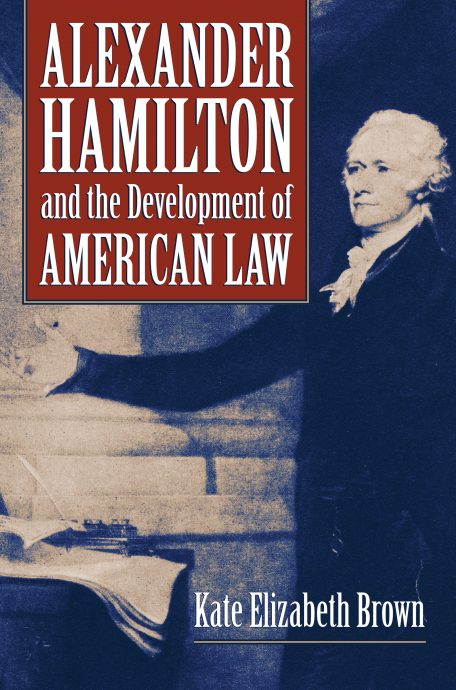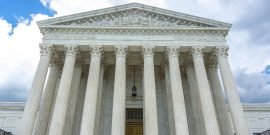Hamilton the Lawyer
Alexander Hamilton’s major contributions to the American Founding—lead author of The Federalist, and the nation’s first Secretary of the Treasury—are well-known, and his remarkable personal story—arriving on the scene as an orphan immigrant, and departing as the dueling victim of the country’s third Vice President—is no less familiar. Hamilton is not so well-known, however, as a lawyer. This is a pity, because he was regarded, by those in a position to know, as one of the greatest lawyers of his generation.
James Kent, the famous judge and commentator on American law, held Hamilton to be the leading figure of the New York bar in his day, remarking in one case how “Colonel Hamilton, by means of his fine melodious voice, his reasoning powers and persuasive address, soared far above all competition.”[1] Supreme Court Justice Joseph Story claimed that he “had heard Samuel Dexter, John Marshall, and Chancellor Livingston say that Hamilton’s reach of thought was so far beyond theirs that by his side they were schoolboys—rush tapers before the sun at noon day.”[2]
Since Hamilton deserves to be better known and better understood as a lawyer, we should be grateful for Kate Elizabeth Brown’s new study, Alexander Hamilton and the Development of American Law. Turning her attention precisely to what has been most neglected, Brown does not focus on Hamilton as the author of famous and lofty commentaries, like his contributions to The Federalist or his state papers as Secretary of the Treasury—although she certainly refers to them as they bear upon her subject. She seeks rather to explain in detail how Hamilton—both as an administrator and as a lawyer in private practice—dealt with ground-level legal questions, as he and his countrymen sought to found and put in motion a new, republican form of government.
Conundrums of Customs Law and Municipal Taxation
Brown offers her readers entrée into many forgotten, but nonetheless fascinating and important, questions. For example, as Secretary of the Treasury, Hamilton had to figure out whether it was possible to pardon a violator of customs law when part of the fine owed by the violator was supposed to be paid to the person who reported the violation.
This is a tricky question. On the one hand, the Constitution empowers the executive to issue pardons. On the other hand, that power was thought to relate to criminal liability only, and not to extend to the private rights of individuals. In other words, a pardon could absolve a man of his punishment—of what has often been called his “debt to society”—but could not relieve him of what he owed to another individual. For did not the customs law give the informant a legal right to his portion of the fine? Hamilton and his colleagues in the executive branch concluded—quite sensibly, and in accord with analogous English practice, as Brown writes—that the pardon could be issued, but conditioned on the pardoned man’s paying the informant the latter’s portion of the fine.
In another interesting circumstance, Hamilton was confronted with the question whether a municipality could tax the interest on federal securities. The issue arose when William Lowder, the Chairman of Boston’s Board of Assessors, wrote to Hamilton, boldly requesting a list of Bostonian holders of federal bonds, so that the city could tax their interest as personal property.
Hamilton’s response is surprising, in a way. It is not surprising that he refused to comply, but the reason he gave is perhaps not what we would expect. Hamilton is famous for having anticipated, in his Opinion on the Constitutionality of a National Bank, the arguments for a broad reading of the Necessary and Proper Clause that later appeared persuasive to the Supreme Court in McCulloch v. Maryland (1819). The request of the Boston Board of Assessors also gave Hamilton an opportunity to think about a variation on the other issue that later arose in McCulloch: whether a state could tax the activities of the federal government. It is almost certain that Hamilton would have agreed with John Marshall’s ruling in McCulloch that a state could not tax the operations of a federally chartered bank, and with Marshall’s related ruling in Weston v. Charleston (1829) that a city cannot tax the interest on federal securities. Yet in 1791, Hamilton raised no such constitutional objection to Boston’s proposed tax. He simply refused to comply with the Board of Assessors’ request on the grounds that it was incompatible with the public credit of the United States and damaging to “the value of the public stock.”
Hamilton Didn’t Always Side with the Feds
To some extent, the Hamilton revealed in these pages is a familiar figure. Hamilton, for instance, is known as a proponent of an energetic executive. This is the theme of some of his most famous contributions to The Federalist, as well as of his later public writings as Pacificus, in which he defended President Washington’s Neutrality Proclamation. Accordingly, we are not surprised to find, in Brown’s account, Hamilton contending for a substantial executive discretion in the implementation of the nation’s revenue and spending measures—although always conceding, as Brown properly notes, that this discretion must be limited by law.
In other areas, however, Brown shows that Hamilton is a more complex figure than is often understood. He is frequently—and with good reason—presented as a defender of the national authority and even as a centralizer. Nevertheless, he was not a simple partisan of the national government or an unconditional defender of its powers.
He denied, for example, that the federal government could legitimately tax the interest on its own public securities. Such a power would be contrary to the public credit and to public faith. After all, a governmental power to tax—that is, to coercively take away—the very interest that it had voluntarily agreed to pay would be indistinguishable from a simple refusal to pay the interest. And this would in turn render the contracts by which such debt had been incurred little more than a kind of elaborate legal fraud. Here Hamilton was defending not constitutional limits on the federal authority, important as these are, but the moral limits that should restrain any decent, honest government in its dealings with its own citizens.
His Common Law Conservative Side
Hamilton was also, Brown explains, a defender of an “extensive” interpretation of the common law. The constitution of the state of New York contained a provision receiving, or adopting as law in New York, the common law of Great Britain. This provision forced New York lawyers and courts to ask: What is the common law? Is it merely the sum of the decisions of the courts at Westminster? Or is it the whole English legal inheritance, as expressed in innumerable decisions, built up over centuries, in courts operating across the entire realm? Hamilton took the latter, more “extensive” view; and this, too, defies our usual understanding of him as a kind of centralist. Here, after all, he was contending that the political community’s identity is to be found not just in the rulings of its central authority but also in the customs and usages found in its localities.
We are also used to seeing Hamilton as an innovator, the creator of a new financial and economic order. He sought—in opposition to rivals like Thomas Jefferson—an America that left behind its predominantly agrarian character and built up its institutions of finance, industry, and commerce. Nevertheless, Hamilton’s veneration of the whole of the common law marks him, again, as a kind of conservative trying to chart a way forward by the light of principles deeply rooted in his civilization’s past.
Finally, we quite reasonably consider Hamilton, especially in contrast to Jefferson, to be a defender of public order and the public authority. Hamilton was a revolutionary, but one who worried that the spirit of 1776, if not channeled properly, might habituate people to disobedience and lawlessness. When, in the early 1790s, the Whiskey Rebellion arose in opposition to the excise tax, Hamilton thought the disturbances would in the end have to be suppressed by the threat of force, so everyone could see that the government could not be defied with impunity. (Jefferson tended to view such rebellions, within limits, as a healthy thing in a republic.)
His Civil Libertarian Side
Brown reminds us, however, that Hamilton, while certainly a proponent of public order and authority, was also a zealous defender of individual rights. As a young lawyer, he applied his considerable intelligence and energy to defending loyalists against the punitive and illiberal laws that New York had enacted against them in the wake of the War of Independence. Later, after his public career had come to a close, he argued for a liberal interpretation of libel law. Rejecting more restrictive and plaintiff-friendly doctrines, Hamilton contended that the truth of a man’s claims should be a defense against a charge of libel, and that a jury (not a judge) should properly decide the legal question of whether the accused is guilty of such a charge.
Throughout her book, Brown does an admirable job of bringing Hamilton’s concerns to light and explaining their significance to the contemporary reader. Nevertheless, I think that in one case—not central to her own argument, but certainly important to our understanding of American constitutionalism—Brown makes a misstep and inadvertently invites readers to project back onto Hamilton a modern view that he probably did not entertain. She suggests that Hamilton—and, following him, John Marshall—“considered the federal courts to be the national government’s ultimate constitutional expositor” or “final constitutional arbiter.” This is a common belief today, but in my view it is mistaken.
If one turns to Hamilton’s Federalist 78, or to Marshall’s opinion in Marbury v. Madison (1803), one will certainly find powerful defenses of the power of judicial review, or the idea that courts must, in the conduct of their duties, consider the constitutionality of the laws they are applying. One can search those authoritative texts in vain, however, for any conclusive evidence that their authors believed that the constitutional views of the courts are necessarily supreme over those of the other branches of the federal government. Belief in the judicial branch as the “final expositor” whose views necessarily control those of the other branches is a modern development unknown to Hamilton and Marshall, even if it is often attributed to them.
That aside, Alexander Hamilton and the Development of American Law is a worthy contribution to the growing body of scholarship on Hamilton, and an important step in enhancing our understanding of his significance as a legal practitioner.
[1] The Political Writings of Alexander Hamilton, Volume II, edited by Carson Holloway and Bradford P. Wilson (Cambridge University Press, 2017), 608.
[2] Quoted in Alexander Hamilton: A Biography, by Forrest McDonald (W.W. Norton and Company, 1979), 314.


